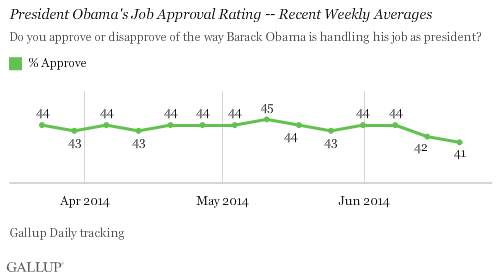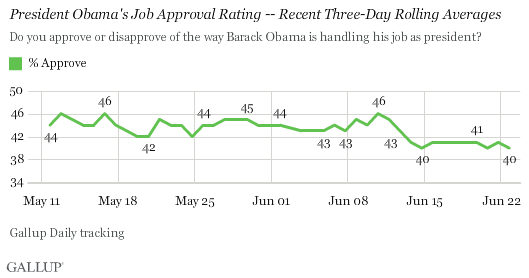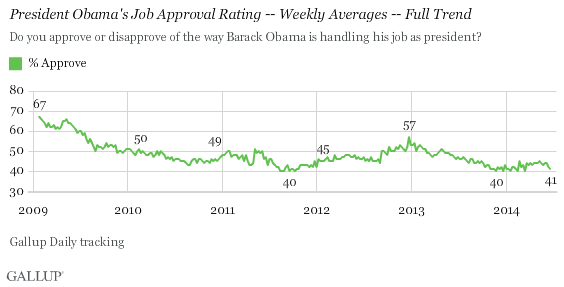PRINCETON, NJ -- The situation in Iraq seems to be taking a toll on President Barack Obama's public standing. His weekly job approval rating is down a total of three percentage points over the last two weeks, to 41%. While this drop is not large in absolute terms, it is notable because it follows nearly three months in which his job approval averaged 44% with little week-to-week variation.

The long stretch of stability from mid-March to early June occurred during a period that was hardly uneventful for the president, including controversies over medical care for U.S. military veterans at Veterans Affairs hospitals and a prisoner exchange of five Taliban detainees for U.S. Army Sgt. Bowe Bergdahl. But Iraq may be the issue weighing most heavily on Obama's public support given the timing of the drop in approval.
Obama's approval rating in Gallup Daily tracking first showed signs of decline (from the mid- to the low 40s) in the immediate days after Islamic militants took control of Mosul, the second-largest city in Iraq, on June 10. The Gallup Daily tracking three-day average for June 11-13, based on fully post-Mosul interviewing, was 41%, and Obama's approval rating has been either 40% or 41% in each subsequent measurement up through June 22 interviewing.

Obama Job Approval Close to Personal Low
Obama's latest weekly job approval average of 41% is just one point higher than his low. His average 55% disapproval last week is the worst so far in his administration.
Obama's 40% weekly approval averages have occurred several times during his presidency, including last fall after the troubled rollout of major provisions of the healthcare law, and in late summer and early fall of 2011 after the contentious agreement to raise the debt ceiling.

Obama's lowest approval rating among Gallup's three-day rolling averages to date is 38%, slightly lower than his worst weekly average. The 38% reading has been recorded several times, all in August and October 2011 after the debt-limit agreement led to the downgrading of the U.S. credit rating and a period of volatility in the stock market. His Gallup Daily tracking approval rating has yet to drop below 40% in recent days.
Democrats', Independents' Support for President Dipping
An average of 76% of Democrats now approve of the job President Obama is doing, down from 80% before the recent slide. Independents show a drop of three points, from 38% to 35%. Republican approval -- extremely low to begin with, at 10% -- averaged 9% last week.

Democratic approval of Obama has been solid throughout his presidency, only dropping to as low as 72% in late October 2011.
Implications
President Obama has already decided to send military advisers to Iraq, and he and his foreign policy team are weighing other options short of sending combat troops to stabilize the situation there. The difficult situation, more so than other recent controversies, seems to be taking a toll on his public support.
The drop in public support is unwelcome news for his party this election year, given that presidential approval ratings are an important predictor of midterm election outcomes. If Obama's 41% weekly job approval rating persists through November, it would be higher than only George W. Bush's 38% approval at the time of the 2006 election, for recent midterm election years. That year, Republicans lost control of both houses of Congress. Should Obama's approval rating not improve between now and the fall, that would certainly weaken Democrats' ability to retain control of the U.S. senate in this fall's elections.
Explore President Obama's approval ratings in depth and compare them with those of past presidents in the Gallup Presidential Job Approval Center.
Survey Methods
Results for this Gallup poll are based on telephone interviews conducted June 16-22, 2014, on the Gallup Daily tracking survey, with a random sample of 3,553 adults, aged 18 and older, living in all 50 U.S. states and the District of Columbia.
For results based on the total sample of national adults, the margin of sampling error is ±4 percentage points at the 95% confidence level.
Interviews are conducted with respondents on landline telephones and cellular phones, with interviews conducted in Spanish for respondents who are primarily Spanish-speaking. Each sample of national adults includes a minimum quota of 50% cellphone respondents and 50% landline respondents, with additional minimum quotas by time zone within region. Landline and cellular telephone numbers are selected using random-digit-dial methods. Landline respondents are chosen at random within each household on the basis of which member had the most recent birthday.
Samples are weighted to correct for unequal selection probability, nonresponse, and double coverage of landline and cell users in the two sampling frames. They are also weighted to match the national demographics of gender, age, race, Hispanic ethnicity, education, region, population density, and phone status (cellphone only/landline only/both, and cellphone mostly). Demographic weighting targets are based on the most recent Current Population Survey figures for the aged 18 and older U.S. population. Phone status targets are based on the most recent National Health Interview Survey. Population density targets are based on the most recent U.S. census. All reported margins of sampling error include the computed design effects for weighting.
In addition to sampling error, question wording and practical difficulties in conducting surveys can introduce error or bias into the findings of public opinion polls.
For more details on Gallup's polling methodology, visit www.gallup.com.
